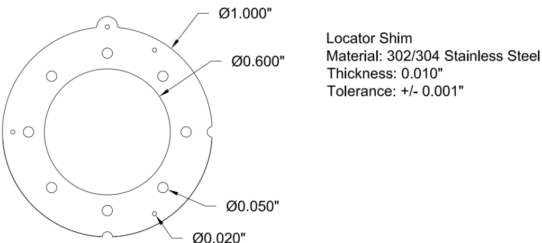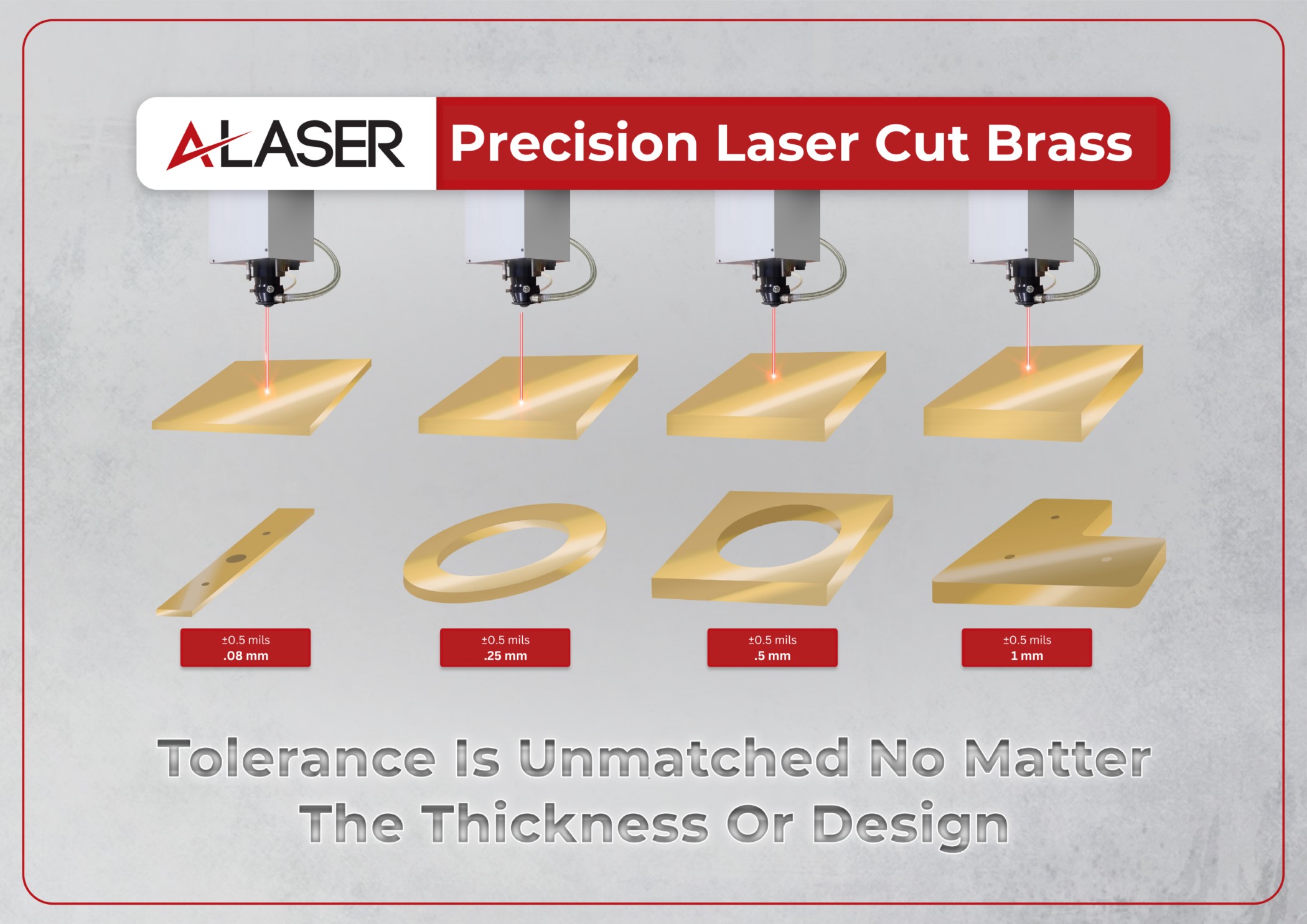Custom Shims Service

What is a Shim?
A shim is a way to level off or align a piece of equipment, system or structure to function properly. An example you might find at home is any door frame. If you could x-ray the area, you probably will see a shim made from thin wood placed in between the door casement and framing structure. This is done to keep the door opening and closing without binding on one of the edges. The shim is used to move the structure slightly and give a true right angle to the corners. For housing construction, this is common to use and is a part of any carpenter’s tricks of the trade. For industrial uses there are metal shims made from stainless steel, custom plastic shims, polymers and others. Precision component manufacturers use methods like laser cutting shims, steel rule die-cutting or stamping to create shims and often they will be using such tools in house for their own applications. Shims also serve high profile industries like aerospace and oil and gas for precision adjustments. The material choice is defined by the application and requirements of the shim to the device or machine that needs this type of adjustment. Since there is more to shims and what they are used for, these examples listed help will give a clearer picture:
- Adjusting Clearances and Tolerances: Custom shims are used to achieve the exact gaps needed between parts in applications like bearings. Critical parts like these require tight tolerances for smooth operation and to prevent seizing. Turbines used in aerospace and flanges used in oil and gas applications, use shims. Shims can also be used to compensate for wear of aging equipment by establishing the correct spacing and gaps.
- Reduction of Noise and Slack: Shims can be used to reduce or eliminate noise in machinery. An example of this is dampening vibrations that might cause noise in equipment during operation. Shims can also be placed between components to reduce slack and create a smoother function.
- Alignment and Leveling: Shim manufacturers themselves need precisely aligned and level equipment for proper operation and to avoid wear and tear. Metal shims made from stainless steel for corrosion resistance or plastic are used to achieve this alignment by placing them between components. Where pumps, motors and conveyor systems are used, shims are needed for aligning of these components.
- Tolerance Control: Manufacturing tolerances in many industries require parts to fit extremely tight. Shims help compensate for slight variations and ensure parts fit together flawlessly.
- Repairing Worn Parts: Shims can act as a temporary fix for slightly worn parts. By filling small gaps caused by wear, they can restore functionality until a permanent replacement can be made. This is commonly seen in applications like valves or pump seals.
Custom plastic shims, metal shims, laser cut custom shims, stamped shims or CNC milled shims are made to function as part of system, often to adjust the alignment or level and allows the supported machine or process to operate correctly. Shims are basic tools but provide in some cases very critical solutions to keep vibrations and clearances at proper design parameters. When you hear a machine clanking or even your washer vibrating loudly, those may function better by having shims installed or adjusted.
What is the best material for shims?
The best material for shims depends on the specific application, but some common choices include stainless steel (metal shims), high-density polyethylene (HDPE) plastic (custom plastic shims), wood, and low-grade plastics. Here’s a breakdown of some factors to consider when selecting shim material:
- Application Requirements: Consider factors like the environment the shim will be in (exposure to moisture, chemicals, or extreme temperatures), the level of stress or pressure the shim will experience, and the required precision of the fit.
- Material Properties: Different materials offer various advantages. Here are some examples:
- Strength and Durability: For high-stress applications, shim stock made from stainless steel (metal shims) or high-density polyethylene (HDPE) plastic (custom plastic shims) might be suitable.
- Corrosion Resistance: Stainless steel excels in environments with moisture or chemicals.
- Cost-Effectiveness: Wood or lower-grade plastics might be appropriate for non-critical applications where cost is a major concern.
- Formability: If the shim needs to be bent or shaped during installation, some plastics like HIPS (High-Impact Polystyrene) offer more flexibility than metals.
Overall, the best material for shims depends on the specific needs of the project. By considering the application requirements and material properties, you can choose the most appropriate shim material for optimal performance.
Manufacturing Plastic Shims
Plastics shims are cut by several methods to support different needs in multiple industries. You can find plastics shims processed for their durability, strength and moisture resistance out of ABS and HDPE plastics and others. Manufacturing custom plastic shims is done by laser technology and steel rule die-cutting for many applications. Shims in general serve a purpose by providing needed adjustments to machinery and critical industrial applications. Custom shims made from plastics benefit the construction industry, flooring installation, appliance applications and more. The following table gives examples of plastic materials used for shims and where and how they are applied.
| Plastic Material | Characteristics | Applications |
|---|---|---|
| HDPE | Durability, wear resistance, moisture resistant, cost effective. | Used in industries like construction and industrial environments. |
| ABS | Strength for impact resistance qualities. | Good for applications where potential force or pressure can be exerted on the shim. |
| Polypropylene (PP) | Light weight and flexible | Good impact resistance applications. |
| Nylon | Resistance to abrasion and wear but has good strength with stiffness. | Industrial applications. |
| High-Impact Polystyrene (HIPS) | Has more formability than other plastics and can be slightly bent or shaped during assembly. It is like HPDE in cost effectiveness. | Electronics for shimming components, automotive and construction. |
| Recycled Plastics | Carbon footprint reduction. Recycled plastics for countless applications, including shims. | Construction and other industries and customers wishing to reduce the carbon footprint. |
Precision component manufacturers are always being asked to take their expertise producing geometries that in some ways are part of a larger assembly like a gear or valve or perhaps a direct product like medical surgical tools. Their knowledge is also valuable in materials and how they can be processed to manufacture the desired custom part. When manufacturing plastic shims, the need for these types of tools and for the specific plastic material is done many times by laser technology and steel rule die cutting. Laser technology or sometimes to referred as CNC, (Computer Numeric Control) laser technology is very versatile in the materials that can be cut. These types of systems use a beam of intensified light to ablate and cut through metallic materials like copper, stainless steel, and tungsten but also non-metallics like ABS, HDPE, polyimides, Peek and many more. Manufacturers can use laser cutting shims technology that has the benefit of versatility in cutting intricate shapes, and accuracy. Steel rule die-cutting uses the sharpened edges of the die to cut through the plastic material. This process often will be used for higher production volumes. You can think of steel-rule die cutting as a larger and more precise cookie cutter.
What Is The Best Metal for Shims?
Stainless Steel
Widely regarded as the best metal for shims due to its exceptional combination of properties:
- High Strength and Durability: Stainless steel can withstand significant loads and forces without deforming or breaking.
- Corrosion Resistance: Stainless steel’s chromium content makes it highly resistant to rust and other forms of corrosion, allowing it to function effectively in environments with moisture or chemicals.
- Dimensional Stability: Stainless steel maintains its shape well over time, ensuring consistent performance in your application.
- Versatility: Stainless steel comes in various thicknesses and grades, offering a variety of options to suit specific needs.
Stainless steel is an excellent choice for shims, but other materials like brass, grafoil, and aluminum can also be ideal in specific situations due to their unique properties.

Brass Shims
Brass is an alloy of copper and zinc, offering distinct advantages in certain applications:
- Electrical Conductivity:
- Best for Electrical Applications: Brass is an excellent conductor of electricity, making it suitable for applications where electrical conductivity is required.
- Corrosion Resistance:
- Specific Environments: Brass is highly resistant to corrosion, especially in environments where it is exposed to water, salts, and mild acids, although not as resistant as stainless steel in harsh conditions.
- Malleability:
- Easy Forming: Brass is more malleable than stainless steel, allowing it to be easily formed into complex shapes and sizes, making it useful for custom applications.
- Low Friction:
- Moving Parts: Brass has a lower coefficient of friction, which is beneficial in applications where shims are in contact with moving parts, reducing wear and tear.
- Aesthetic Appeal:
- Decorative Uses: The gold-like appearance of brass makes it suitable for decorative applications.

Aluminum and Grafoil Shims
Aluminum is a lightweight and versatile metal with distinct properties. Grafoil, is metalized carbon material that often is used for shims and gaskets. Both have great characteristics such as:
Aluminum
- Lightweight:
- Weight-Sensitive Applications: Aluminum is much lighter than stainless steel, making it ideal for applications where weight is a critical factor, such as in aerospace or automotive industries.
- Corrosion Resistance:
- Moderate Corrosion Resistance: Aluminum naturally forms a protective oxide layer that helps prevent corrosion, suitable for many outdoor applications but less effective in highly acidic or alkaline environments compared to stainless steel.
- Thermal Conductivity:
- Heat Dissipation: Aluminum has excellent thermal conductivity, making it suitable for applications where heat dissipation is important, such as in heat exchangers or electronic devices.
Grafoil
- Malleability and Workability:
- Ease of Machining: Grafoil is easier to cut compared to aluminum and stainless steel. Its characteristic of formability make it beneficial for applications requiring precise fabrication and complex shapes.
- Cost-Effectiveness:
- Budget Considerations: Offers a cost-effective solution for many applications where its unique properties (thermal conductivity, electrical conductivity, compressibility) are beneficial.
While stainless steel remains the top choice for its high strength, durability, and superior corrosion resistance, brass, aluminum and grafoil are great metallic material solutions, offering advantages from using each. Selecting the best metal for shims depends on the specific requirements of the application, including factors like environmental conditions, load-bearing needs, thermal considerations, and budget constraints.
